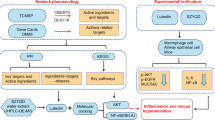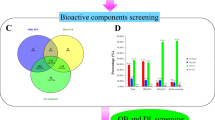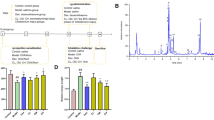Abstract
Objective
Asthma is a chronic immune disease that has become a serious public health problem. The currently available medications are not ideal because of their limitations and side effects; hence, new target proteins and signaling cascades for precise and safe therapy treatment are needed. This work established an ovalbumin-induced asthma rat model and treated it with total flavonoid extract from the Xinjiang chamomile. The proteins that were differentially expressed in the chamomile extract-treated asthmatic rats and the asthma and healthy rat groups were identified using isobaric tagging followed by LC-MS/MS. Kyoto encyclopedia of genes and genomes pathway analysis of the differentially expressed proteins was performed.
Results
Pathways involved in purine metabolism, herpes simplex infection, and JNK phosphorylation and activation mediated by activated human TAK1 were enriched, indicating the intrinsic links between the mechanism of asthma development and treatment effects. Furthermore, we constructed a protein–protein interaction network and identified KIF3A as a potential target protein of chamomile extract that affected the Hedgehog signaling pathway.
Conclusions
This study may provide new insights into the pathogenesis of asthma and reveal several proteins and pathways that could be exploited to develop novel treatment approaches.





Similar content being viewed by others
Data availability
The data that support the findings of this study are available from the corresponding author upon reasonable request.
Reference
Barakat MT, Humke EW, Scott MP (2013) Kif3a is necessary for initiation and maintenance of medulloblastoma. Carcinogenesis 34:1382–1392. https://doi.org/10.1093/carcin/bgt041
Bezemer GF, Sagar S, van Bergenhenegouwen J, Georgiou NA, Garssen J, Kraneveld AD, Folkerts G (2012) Dual role of Toll-like receptors in asthma and chronic obstructive pulmonary disease. Pharmacol Rev 64:337–358. https://doi.org/10.1124/pr.111.004622
Bryant CE, Gay NJ, Heymans S, Sacre S, Schaefer L, Midwood KS (2015) Advances in Toll-like receptor biology: modes of activation by diverse stimuli. Crit Rev Biochem Mol Biol 50:359–379. https://doi.org/10.3109/10409238.2015.1033511
Demoly P, Demoly P, Basset-Seguin N, Chanez P, Campbell AM, Bousquet J (1992) C-fos proto-oncogene expression in bronchial biopsies of asthmatics. Am J Respir Cell Mol Biol 7:128–133. https://doi.org/10.1165/ajrcmb/7.2.128
Eynott PR, Nath P, Leung SY, Adcock IM, Bennett BL, Chung KF (2003) Allergen-induced inflammation and airway epithelial and smooth muscle cell proliferation: role of Jun N-terminal kinase. Br J Pharmacol 140:1373–1380. https://doi.org/10.1038/sj.bjp.0705569
Fabbretti E, Nistri A (2012) Regulation of P2 × 3 receptor structure and function. CNS Neurol Disord Drug Target 11:687–698. https://doi.org/10.2174/187152712803581029
Fahy JV (2015) Type 2 inflammation in asthma–present in most, absent in many. Nat Rev Immunol 15:57–65. https://doi.org/10.1038/nri3786
Folkesson HG, Kuzenko SR, Lipson DA, Matthay MA, Simmons MA (2012) The adenosine 2A receptor agonist GW328267C improves lung function after acute lung injury in rats. Am J Physiol Lung Cell Mol Physiol 303:L259–L271. https://doi.org/10.1152/ajplung.00395.2011
Fredholm BB, AP IJ, Jacobson KA, Linden J, Muller CE (2011) International union of basic and clinical pharmacology. LXXXI. Nomenclature and classification of adenosine receptors—an update. Pharmacol Rev 63:1–34. https://doi.org/10.1124/pr.110.003285
Fuchs O, Bahmer T, Rabe KF, von Mutius E (2017) Asthma transition from childhood into adulthood. Lancet Res Med 5:224–234. https://doi.org/10.1016/S2213-2600(16)30187-4
Giridhar PV et al (2016) Airway epithelial KIF3A regulates Th2 responses to aeroallergens. J Immunol 197:4228–4239. https://doi.org/10.4049/jimmunol.1600926
Goetz SC, Anderson KV (2010) The primary cilium: a signalling centre during vertebrate development. Nat Rev Genet 11:331–344. https://doi.org/10.1038/nrg2774
Haggag EG, Abou-Moustafa MA, Boucher W, Theoharides TC (2003) The effect of a herbal water-extract on histamine release from mast cells and on allergic asthma. J Herb Pharmacother 3:41–54. https://doi.org/10.1080/j157v03n04_03
Hausmann R, Schmalzing G (2012) P2 × 1 and P2 × 2 receptors in the central nervous system as possible drug targets. CNS Neurol Disord Drug Target 11:675–686. https://doi.org/10.2174/187152712803581128
Kaiko GE et al (2013) Toll-like receptor 7 gene deficiency and early-life Pneumovirus infection interact to predispose toward the development of asthma-like pathology in mice. J Allergy Clin Immunol 131:1331–1339 e1310. https://doi.org/10.1016/j.jaci.2013.02.041
Khorasanizadeh M, Eskian M, Gelfand EW, Rezaei N (2017) Mitogen-activated protein kinases as therapeutic targets for asthma. Pharmacol Ther 174:112–126. https://doi.org/10.1016/j.pharmthera.2017.02.024
Kim BS, Mehra S, Yawn B, Grose C, Tarrell R, Lahr B, Juhn YJ (2013) Increased risk of herpes zoster in children with asthma: a population-based case-control study. J Pediatr 163:816–821. https://doi.org/10.1016/j.jpeds.2013.03.010
Kovacic MB et al (2011) Identification of KIF3A as a novel candidate gene for childhood asthma using RNA expression and population allelic frequencies differences. PLoS ONE 6:e23714. https://doi.org/10.1371/journal.pone.0023714
Koyama E et al (2007) Conditional Kif3a ablation causes abnormal hedgehog signaling topography, growth plate dysfunction, and excessive bone and cartilage formation during mouse skeletogenesis. Development 134:2159–2169. https://doi.org/10.1242/dev.001586
Kwon HJ et al (2016) Asthma as a risk factor for zoster in adults: A population-based case-control study. J Allergy Clin Immunol 137:1406–1412. https://doi.org/10.1016/j.jaci.2015.10.032
Li K et al (2016) Effects of fastigial nucleus electrostimulation on airway inflammation and remodeling in an experimental rat model of asthma. Asian Pac J Allergy Immunol 34:223–228. https://doi.org/10.12932/AP0705
Nath P, Eynott P, Leung SY, Adcock IM, Bennett BL, Chung KF (2005) Potential role of c-Jun NH2-terminal kinase in allergic airway inflammation and remodelling: effects of SP600125. Eur J Pharmacol 506:273–283. https://doi.org/10.1016/j.ejphar.2004.11.040
Pearson G, Robinson F, Beers Gibson T, Xu BE, Karandikar M, Berman K, Cobb MH (2001) Mitogen-activated protein (MAP) kinase pathways: regulation and physiological functions. Endocr Rev 22:153–183. https://doi.org/10.1210/edrv.22.2.0428
Qian L, Jun L, Juan L (2017) Mechanism of n-butanol extract of chamomile on asthma model mice. Chin Tradit Pat Med 39(12):2603–2606. https://doi.org/10.3969/j.issn.1001-1528.2017.12.036
Ranjbar A, Mohsenzadeh F, Chehregani A, Khajavi F, Zijoud SM, Ghasemi H (2014) Ameliorative effect of Matricaria chamomilla L. on paraquat: induced oxidative damage in lung rats. Pharmacogn Res 6:199–203. https://doi.org/10.4103/0974-8490.132595
Rodrigues JQ et al (2014) Differential regulation of atrial contraction by P1 and P2 purinoceptors in normotensive and spontaneously hypertensive rats. Hypertens Res 37:210–219. https://doi.org/10.1038/hr.2013.146
Sabater JR, Mao YM, Shaffer C, James MK, O'Riordan TG, Abraham WM (1999) Aerosolization of P2Y(2)-receptor agonists enhances mucociliary clearance in sheep. J Appl Physiol 87:2191–2196. https://doi.org/10.1152/jappl.1999.87.6.2191
Sobieraj DM, Baker WL (2018) Medications for asthma. JAMA 319:1520. https://doi.org/10.1001/jama.2018.3808
Srivastava JK, Gupta S (2007) Antiproliferative and apoptotic effects of chamomile extract in various human cancer cells. J Agric Food Chem 55:9470–9478. https://doi.org/10.1021/jf071953k
Watkins DN, Berman DM, Burkholder SG, Wang B, Beachy PA, Baylin SB (2003) Hedgehog signalling within airway epithelial progenitors and in small-cell lung cancer. Nature 422:313–317. https://doi.org/10.1038/nature01493
Wenzel SE (2012) Asthma phenotypes: the evolution from clinical to molecular approaches. Nat Med 18:716–725. https://doi.org/10.1038/nm.2678
Winters SL, Davis CW, Boucher RC (2007) Mechanosensitivity of mouse tracheal ciliary beat frequency: roles for Ca2+, purinergic signaling, tonicity, and viscosity. Am J Physiol Lung Cell Mol Physiol 292:L614–L624. https://doi.org/10.1152/ajplung.00288.2005
Wise J (2014) Corticosteroids for asthma may suppress growth in children in first year of treatment, researchers say. BMJ 349:g4623. https://doi.org/10.1136/bmj.g4623
Xie S, Sukkar MB, Issa R, Oltmanns U, Nicholson AG, Chung KF (2005) Regulation of TGF-beta 1-induced connective tissue growth factor expression in airway smooth muscle cells. Am J Physiol Lung Cell Mol Physiol 288:L68–L76. https://doi.org/10.1152/ajplung.00156.2004
Yu M et al (2016) Aberrant purine metabolism in allergic asthma revealed by plasma metabolomics. J Pharm Biomed Anal 120:181–189. https://doi.org/10.1016/j.jpba.2015.12.018
Acknowledgements
This work was supported by Xinjiang Uygur Autonomous Region Natural Science Fund (2018D01C284).
Supporting information
Fig. S1—Lung tissues proteins identified by LC-MS/MS. (A) is peptides length distribution and (B) is protein molecular weight and coverage distribution.
Fig S2—Quantitative analysis of protein expression between G and M group. (A) as well as M and N group (B) by Image J software. The expression was normalized to β-actin. The data were reported as mean ± SD, n = 3. **significant difference, P < 0.01; *significant difference, P < 0.05.
Author information
Authors and Affiliations
Contributions
QL and JZ made substantial contributions to conception and design, acquisition of data, analysis and interpretation of data; JL, XK and HZ performed the experiments; GZ and FZ have been involved in drafting the manuscript or revising it critically for important intellectual content; JN, XY and XX given final approval of the version to be published. HAA agreed to be accountable for all aspects of the work in ensuring that questions related to the accuracy or integrity of any part of the work are appropriately investigated and resolved.
Corresponding author
Ethics declarations
Conflict of interest
The authors declare that they have no conflict of interest.
Ethical approval
All procedures performed in studies involving animals were in accordance with the ethical standards of the institution or practice at which the studies were conducted. (Laboratory Animal Ethics Committee of Xinjiang Medical University, NO: IACUC20161018-01).
Additional information
Publisher’s Note
Springer Nature remains neutral with regard to jurisdictional claims in published maps and institutional affiliations.
Electronic supplementary material
Below is the link to the electronic supplementary material.
10529_2020_2825_MOESM1_ESM.tif
Electronic supplementary material 1 Fig S1. Lung tissues proteins identified by LC-MS/MS. (A) is peptides length distribution and (B) is protein molecular weight and coverage distribution. (TIF 1530 kb)
10529_2020_2825_MOESM2_ESM.tif
Electronic supplementary material 2 Fig. S2. Quantitative analysis of protein expression between G and M group. (A) as well as M and N group (B) by Image J software. The expression was normalized to β-actin. The data were reported as mean ± SD, n = 3. **significant difference, P < 0.01; *significant difference, P < 0.05. (TIF 79 kb)
Rights and permissions
About this article
Cite this article
Li, Q., Zhao, S., Lu, J. et al. Quantitative proteomics analysis of the treatment of asthma rats with total flavonoid extract from chamomile. Biotechnol Lett 42, 905–916 (2020). https://doi.org/10.1007/s10529-020-02825-0
Received:
Accepted:
Published:
Issue Date:
DOI: https://doi.org/10.1007/s10529-020-02825-0




